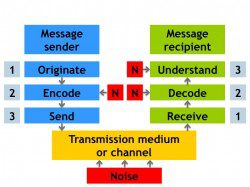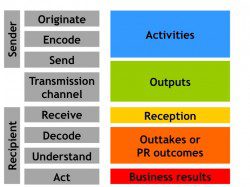 This is the fourth in a series of five blog posts for Measurement Week.
This is the fourth in a series of five blog posts for Measurement Week.
In my professional practice, speaking engagements, training seminars, and teaching, we always begin with a look at communications theory and models of communications. Bear with me before dismissing this approach as overly academic or, well, too “theoretical.” Why begin here? First, theory provides a bridge to the research in fields such as neuroscience, cognitive psychology, behavioral economics, network theory, and anthropology. Second, theory compels us to look broadly across the full communications process, and counteracts tendencies to focus measurement on outputs. Third, a well-reasoned model provides a structure pushing us to identify specific metrics relevant to the client organization. Fourth, as we engage our clients in developing the metrics they have ownership of the measurement system. They have the opportunity to add complexity to the plain vanilla model by adding feedback loops, reinforcement, and intermediary actors. Finally, our model leads us towards a classic and very practical balanced scorecard (in the true Kaplan and Norton sense) consisting of core metrics required for strategic and tactical management.
We start with a simple seven-stage model consisting of activities, outputs, engagement, cognitive change (often referenced as outtakes), communications outcomes, and business results. Activities consist of the internal operations of a public relations group. Activities are generally visible, and activity metrics gauge the internal efficiency of the public relations team. Outputs measure the availability of messages to target audiences, and can be correlated with activities. Engagement measures the reception and handling of communications outputs by target recipients, yet precedes any change in awareness, attitude, or understanding. Cognitive change (often referenced as “outputs”) is the result of receiving, processing, and understanding communications. Cognitive change includes awareness, knowledge, relevance, intent, action, and advocacy (for more information, click here). Often, public relations and corporate communications operate at this level, with measurement of cognitive change the final step in a campaign. The next stage, communications results or public relations results consists of specific, desired cognitions and behaviors. Communications results precede business results. Finally business results consist of measurable outcomes important to the organization. Often, these results can be measured in financial terms. In this situation, when both the investment and the return can be measured in financial terms, return-on-investment (ROI) analysis may be relevant.
Having established a theory-based structure and then identified a set of specific metrics—with full participation and engagement of the communications team—we move to establishing targets. An old axiom goes: “if you don’t know where you are going, you won’t know when you get there.” Said another way: “Targets are necessary for evaluation.” Setting targets comes down to describing success and describing failure. In setting targets, the descriptions should be in the context of results compared to time and expense: What is an acceptable or worthwhile result, given the budget and staff time allocated? The response to this question becomes the target.
What is an unacceptable result, where the effort is clearly is not worthwhile? Unacceptable results suggest that the particular effort needs to be abandoned or significantly modified before it is continued. What is a more than acceptable result? This is a level where there is consensus that the activity was worth considerably more than the investment of time and expense. This is sometimes referred to as a stretch target.
To summarize, we start with a theory-based structure. Then we push to identify relevant metrics as far across the communications process as feasible. Next, we set targets and standards for evaluation. Then, we measure and compile the results into suitable reporting formats such as a balanced scorecard. Finally, we evaluate our results, using our scorecard as a strategic and tactical management tool.
What does this have to do with measurement standards and best practices? The answer is quite simple. By adopting a standard or best practices overall measurement model, public relations professionals will be assured that they are measuring the right things. This theory-based model provides guidance on what to measure. The specific measurement standards provide step-by-step instructions about how to measure. Measuring the wrong things is akin to measuring the cubic meters of ocean water pouring into the hull of a sinking ship. You may have an accurate, reliable answer, but the ship is still sinking.
To conclude, start with a communications model. Second, identify specific metrics relevant to your public relations campaign. This is a standard or best practices approach. Third, set targets for evaluation. Fourth, implement your measurement. Finally, evaluate your results in terms of objectives, and provide feedback to your strategy, tactics, and operations.
David is principal of Geddes Analytics LLC, a boutique research and measurement firm; member and past chair of the Institute for Public Relations Measurement Commission; and Chair of the Coalition for Public Relations Research Standards.





